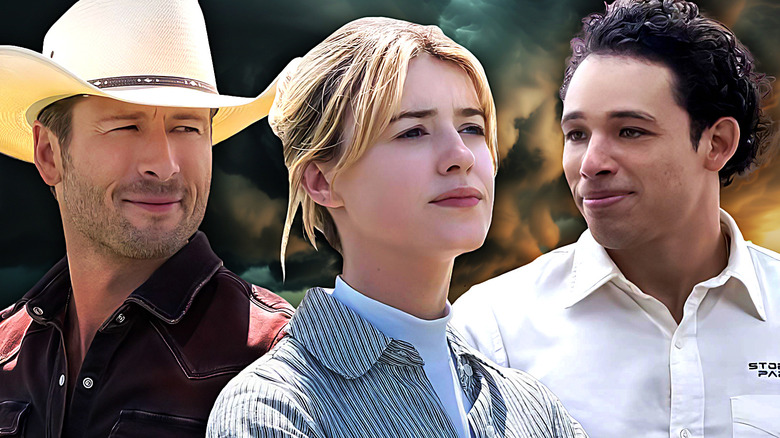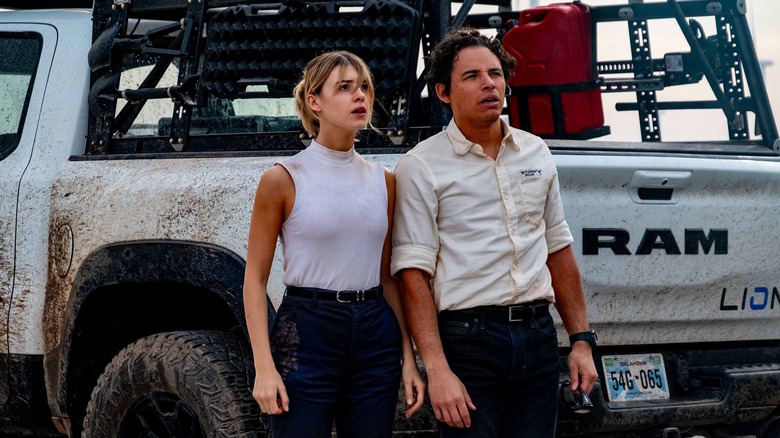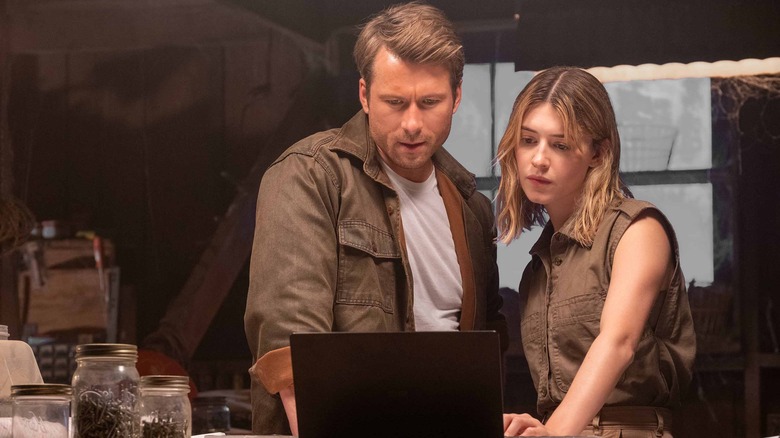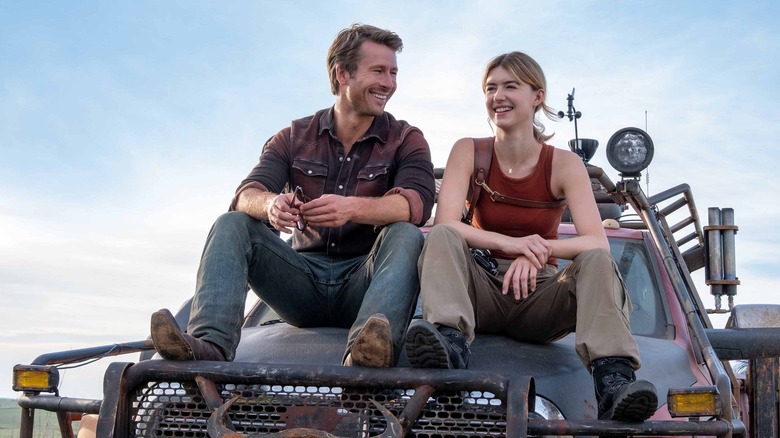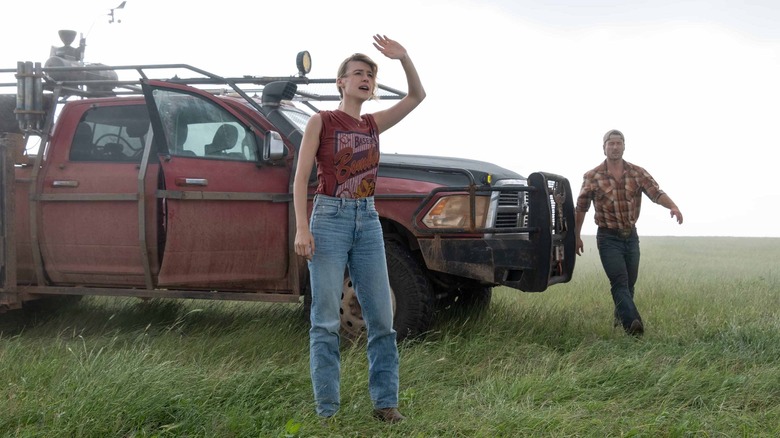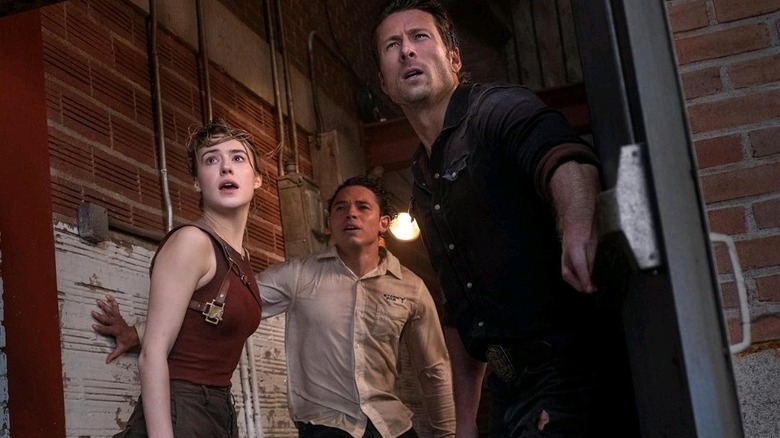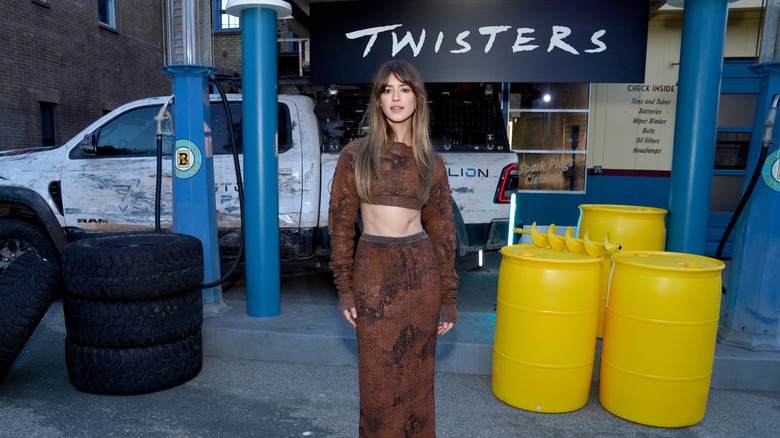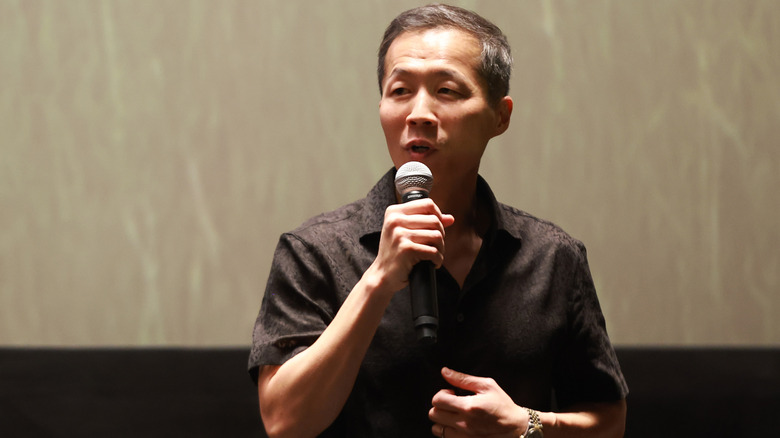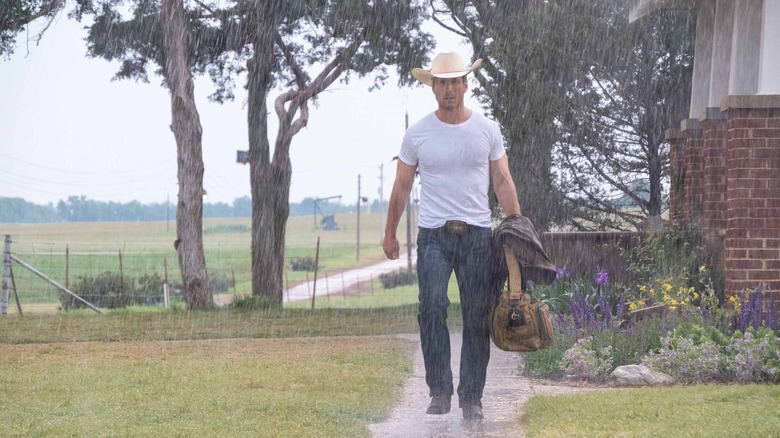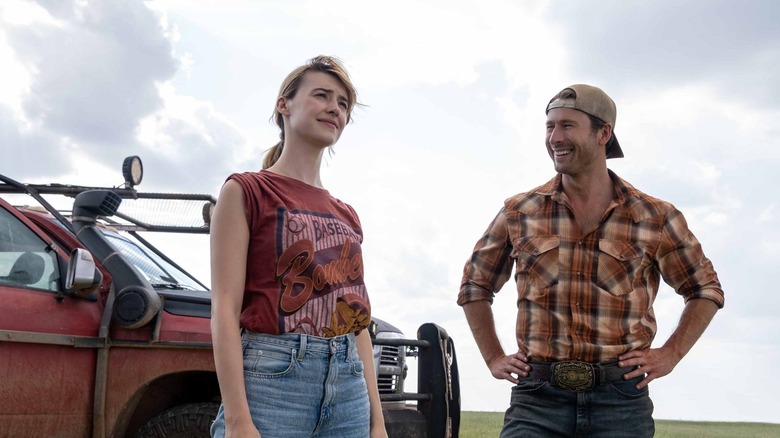The Ending Of Twisters Explained
Contains spoilers for "Twisters"
With "Twisters," director Lee Isaac Chung and screenwriter Mark L. Smith seek to revive a brand of simple high-concept disaster movie moviegoers haven't seen in a while. Loosely a sequel to the Jan de Bont-directed 1996 blockbuster "Twister," the story of "Twisters" stands on its own and can be enjoyed without any knowledge of the previous film, though fans will appreciate some of the homages interspersed throughout.
The appeal of "Twisters" is self-explanatory: If you buy a ticket to this movie, you're not there to be intellectually challenged, but to have fun watching attractive actors in tornado-based danger depicted via great special effects. If the plot of this movie actually needed explaining, it would be a failure by its own standards. But even if everything is narratively straightforward and makes perfect sense, that doesn't mean there isn't stuff to talk about regarding the ending and its themes — and anyone interested in the process of blockbuster filmmaking will certainly be interested to learn more about how the cast and crew pulled off that intense climax.
What you need to remember about the plot of Twisters
"Twisters" opens with a team of storm chasers in Oklahoma testing out a new method of dissipating tornadoes. The test fails, leaving Kate Cooper (Daisy Edgar-Jones) and Javi (Anthony Ramos) the only survivors of the storm. Five years later, Kate has moved to New York, where she works as a meteorologist, but Javi convinces her to return to Oklahoma to help his "StormPar" team track an extra intense tornado season.
As they track storms, Kate, Javi, and his business partner Scott (David Corenswet) develop a rivalry with a team of storm chasers led by the YouTube celebrity "Tornado Wrangler" Tyler Owens (Glen Powell). Tyler takes an interest in the "city girl" Kate, and she eventually agrees to go with him to a rodeo. Alas, a violent tornado ruins this date, destroying the rodeo and much of the town. In the tragic aftermath, Kate and Javi get in a fight, and Kate leaves the team to return to her childhood home.
Kate wants to destroy all her old research, but her mother (Maura Tierney) dissuades her, saying, "I'm still waiting for you to save the world." Tyler finds Kate, realizing he knew about her from reading about her award-winning middle school science project simulating tornadoes in a model town. She tells him about her traumatic past. Talking about how tornadoes are classified by the damage they leave behind, he encourages her to minimize that damage by not giving up her dreams.
What happened at the end of Twisters?
Tyler develops a computer model to simulate Kate's storm dispersal invention, and they figure out a fix for the previous failure: adding a chemical to turn more of the moisture into rain before absorbing it. Making up with Javi and reuniting with Tyler's crew, Kate and Tyler head out to test this theory on one of the tornadoes. However, the tornado hits an oil refinery, setting it aflame and turning it into a genuine monster of a tornado.
Kate and Tyler's crew head into town to help people get to safety. When the business-focused Scott says he doesn't care about the people, Javi leaves him to help with the townspeople. The townspeople take shelter in a movie theater. When Tyler gets stuck under debris from a flipped streetcar, Kate and Javi pull him out just before a water tower collapses, flooding the streets. When even the movie theater gets torn apart by the storm, Kate makes a bold decision to drive into the storm, release the new formula, and save the day — her invention ultimately works, and she succeeds in stopping it.
In the closing scenes, Kate heads to the airport to return to New York. Tyler tries to convince her to stay, to which she replies, "Maybe if you feel it, you should chase it." He decides to go with her into the airport — where all the flights are delayed due to inclement weather. The credits show that she keeps storm chasing with him.
What the ending of Twisters means for Kate
Kate's character arc at the heart of "Twisters" is one of returning to ambitions she had previously given up on, making up for a traumatic failure by giving her goals another go and then succeeding beyond her wildest dreams. With encouragement from friends, family, and a charismatic potential lover, her passion for studying extreme weather and her desire to help others ultimately win out over the sense of guilt and self-doubt that previously derailed her life path.
Kate's a scientist heroine, and having to redo experiments with new adjustments is part of the scientific method — though in her field of the study, the stakes for failure are extreme. She can't undo the storm that killed her colleagues five years ago, but she can choose to face new storms with the same determination she had before.
What the end of Twisters means for the world
So Kate's now-successful tornado-killing formula completely changes the field of meteorology forever, right? Not so fast! Nobody actually saw her release the formula while she was driving alone into the storm. As Javi points out to Kate on their ride to the airport, other people just aren't going to believe her story. Other meteorologists are likely to attribute to the tornado suddenly dying out to various other environmental conditions — for instance, the refinery accident that made it grow in size could also theoretically have caused it to fade away soon after.
Genre considerations prevent Kate from truly "saving the world" — her invention is a science-fiction element in a film that is otherwise trying to ground itself in science-fact, and showing this invention changing the world at large would push the story (and any potential sequels) further away from that semblance of reality into a more speculative realm. Besides, if there are going to be more "Twisters" movies, having a device at the ready that shuts tornadoes down won't exactly make for great drama. Yet even if people don't believe the story of how she did it, Kate is happy to have saved the town and to have faced her greatest fears.
What Twisters does (and doesn't) say about climate change
"Twisters" upping the stakes from the first "Twister" isn't merely following the "same threat but bigger" sequel playbook. It's reflecting the reality of natural disasters growing more frequent and more extreme in the face of climate change. The filmmakers have discussed climate change as one of the film's major themes a lot in the press — but curiously, the phrase "climate change" is not uttered once in the film itself.
Not that "Twisters" needs to say those exact words to make its point. When Kate's mom talks about worsening weather conditions, it will feel familiar to viewers whose lives already impacted by climate disasters, and the visual metaphor of an oil refinery transforming an already strong tornado into a flaming monstrosity isn't exactly subtle in its environmental symbolism.
Director Lee Isaac Chung told CNN that he avoided saying "climate change" in the film so it wouldn't "feel like [it] is putting forward any message." That the acknowledgement of the factual phenomenon of climate change is so politicized as to be deemed a "message" is its own can of worms, but the ambiguity of language used in the script can also be defended on the grounds of there being scientific uncertainty about the specific nature of the connections between climate change and tornadoes. The changing climate is impacting the weather conditions by which tornadoes are most likely to form, but from there, the cause and effect requires more study.
Daisy Edgar-Jones explains how she did those stunts
When "Twister" came out in 1996, the mix of practical effects and innovative computer-generated effects was the big selling point. "Twister" had a wild production, and more of those twister scenes happened in camera than you'd expect. "Twisters" contains much more impressive CGI, but with such effects now commonplace, what is most striking about the new film's disaster sequences is how they meld the digital storms with real locations (filming in Oklahoma was a non-negotiable condition for Lee Isaac Chung's involvement), large-scale practical effects, and intense stunt work.
Daisy Edgar-Jones spoke about the experience of performing the film's big climactic stunts in an interview with Variety. "It felt like being in a theme park," she said. While the falling water tower is clearly a CGI visual, the water that floods out after it falls is all real, she revealed, along with the chandeliers falling when the movie theater gets blown apart. When asked if she got any injuries amidst all the potential danger during these practical effects sequences, Edgar-Jones answered, "No, just really bad hair. I had a lot of stuff in my ears because things would blow in there. They would have to give me these weird ear drops and fizz out all the dirt."
Acting in the film required Edgar-Jones partake in a lot of physical training, particularly for the running scenes. Her "Normal People" co-star Paul Mescal was enduring similar training for "Gladiator II" at the same time, and the two friends supported each other in the process.
Lee Isaac Chung on the significance of the movie theater set piece
The use of the movie theater in the final act of "Twisters" is an homage to the drive-in sequence in the original "Twister," down to the usage of a horror movie playing — instead of Jack Nicholson's Jack Torrance swinging his axe in "The Shining" as the screen blows away, now it's Colin Clive's Dr. Henry Frankenstein from the 1931 "Frankenstein" film screaming, "It's alive!" when the theater gets torn apart by the storm. But the use of the movie theater in the climax is not just a cute reference — it's emblematic of the film's very purpose.
Speaking to IndieWire, Lee Isaac Chung explained his meta intentions for making a movie theater the place of refuge, stating, "From the start, the design of that theater, and the size of the screen, and the special effects, and the stunts happening in that sequence, I had in mind that people would be sitting in their seats watching this thing happen." Understanding the precarity of the film industry in the era of COVID and streaming, the director used the theater sequence as something of a plea for the communal necessity of the theatergoing experience: "I knew there were many jobs counting on the movie, the success of the film, and I knew that theater-going itself, there was some fragility there. Those thoughts came into my mind a lot, and that goes into the theater scene at the end of this film."
What the end of Twisters could mean for franchise potential
As of this writing, nobody knows if there will be more "Twister" movies — and even if a sequel is to happen, nobody knows when it would come out and what that sequel would look like. Twenty-eight years passed between "Twister" and "Twisters," and both movies tell separate stand-alone stories connected mainly by subject matter.
Since Hollywood in the 2020s is more IP-driven than it was in the 1990s, huge box office results for "Twisters" could easily lead to a much shorter wait for a third film. Such a sequel would likely go one of two routes: It could tell yet another stand-alone story about a different set of storm chaser characters, or it could be a direct sequel to "Twisters" and continue Kate and Tyler's adventures together. There's an off-chance it could even tie in characters from the first "Twister," though such an idea has been rejected before — Helen Hunt wanted to make a "Twister" sequel where her character, Dr. Jo Harding, would die in the opening scene before introducing a new diverse cast.
For her part, Daisy Edgar-Jones is open to reprising the role of Kate if she's given a good script for such a sequel. As she told Variety, "I love that world of storm-chasing. I think it would be fun to see what they could do next." However, she does have one concern about a potential third film: the title. "Would they just have to keep adding s's to the end of 'Twisters'?" she speculated.
Twisters' potential alternate ending
It's unknown whether we'll ever see an alternate cut of the "Twisters" ending, but it appears at least one major detail got changed between filming the airport scene and editing the final product. Photos from the set have leaked onto social media platforms including X (formerly Twitter) that show Daisy Edgar-Jones and Glen Powell kissing in the airport. No such kiss appears in the finished film, which instead fades to black just as Kate and Tyler look at each other as if they're about to kiss.
Given the airport scene is already playing in the realm of rom-com cheese, including this kiss would have fit the tone. Given Powell's success as a rom-com star in films like "Anyone But You" and "Hit Man," cutting the kiss out is sure to be disappointing to some of his fans. Was this change a decision to center the focus on Kate and Tyler's professional partnership as opposed to their romantic one? Or is this a symptom of Hollywood movies growing increasingly averse to romance in general? It's hard to say, but expect some theatergoers to be disappointed in the lack of romance between the two incredibly attractive leads of "Twisters."
